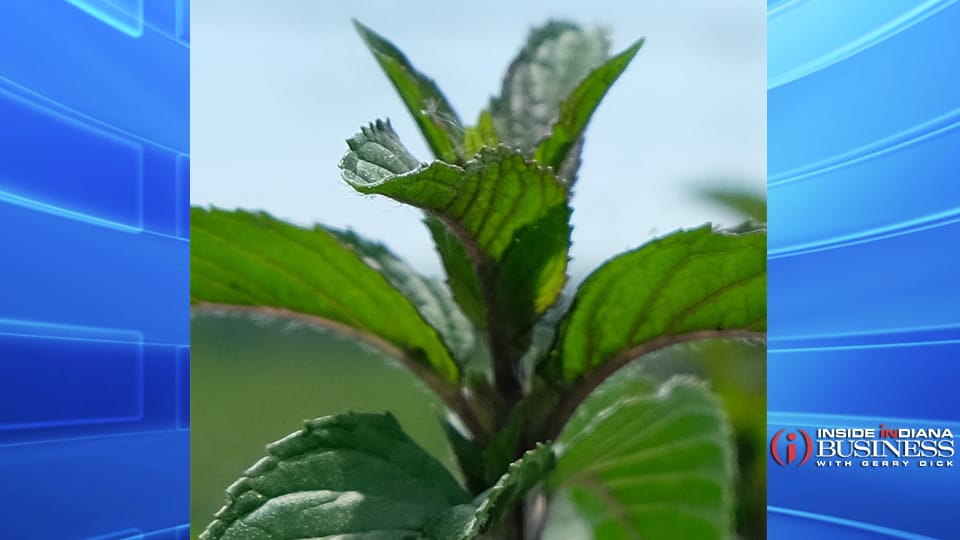Increasing challenges threaten Indiana’s mint oil industry
Subscriber Benefit
As a subscriber you can listen to articles at work, in the car, or while you work out. Subscribe Now
The United States produces approximately 70% of the world’s supply of peppermint and spearmint, and a large amount of that is farmed in northern Indiana.
According to the latest Census of Agriculture, Indiana is the third-largest producer of mint in the country, and the mint that is farmed here is distilled into mint oil that is used in products such as chewing gum, toothpaste and even liqueurs.
But challenges continue to arise that are threatening Indiana’s mint production, which one farmer calls a “dying industry.”
Chris Matthys, whose family farms mint in St. Joseph County, told Inside INdiana Business the marketplace for mint has “completely dissolved” over the past 20 years.
“Competition from synthetic mint components mainly coming out of India and China, those things have really eaten into the demand for North American mint oils,” Matthys said.
The Purdue University College of Agriculture says the acreage for Midwest peppermint, Native and Scotch spearmint declined by 15.2%, 41.5% and 46.2%, respectively, in 2022 compared to the previous year.
Additionally, Matthys says a lack of access to reliable herbicides is another challenge for mint growers, and because the acreage for mint is “a fraction of a fraction” of that for corn and soybeans, there isn’t much research and development of herbicides that are specific to mint.
“Purdue does a ton of research, along with the University of Wisconsin and Washington State and Oregon State, into existing chemicals that could potentially work in peppermint, spearmint, and then convincing the companies that it’s worth applying for the registration of an already existing product,” he said.
The area in northern and northwest Indiana, Matthys said, is conducive to growing mint because of the muck soils that are located there, which can hold onto water more easily, benefitting the small-rooted plants. The amount of sunlight the plants get during the summer is also a key factor for growing mint.
Petrus Langenhoven, a horticulture and hydroponics crop specialist in the Department of Horticulture and Landscape Architecture at Purdue, said disease is also playing a factor in the loss of mint acreage.
“A disease that attacks the roots of the plants has wreaked havoc in terms of acreage, and it’s getting smaller and smaller because growers continue to look for land that hasn’t been affected yet,” Langenhoven said.
Like many other industries, mint growers have been affected by the pandemic, which led to rising production costs.
“The price that growers received per pound of oil, I don’t think that has changed much even with all the price increases on the input side since the pandemic,” said Langenhoven. “And obviously that weighs heavily on growers when they see a great corn or bean out there, so they would rather convert those acres to corn or beans, if it earns them more money.”
Matthys agrees, saying many mint growers are simply getting out of the mint business.
“There’s millions of pounds of oil in storage that growers have and can’t sell,” Matthys said. “So a lot of them, especially with a strong corn and soybean market these last several years, they’ve cut back on the acres. They just haven’t been raising the crop because the market is just telling them that they don’t want it.”
So why do some farmers continue to grow mint despite the challenges? Matthys says it’s because it’s in their blood.
“In my situation, it was my great, grandfather that started raising peppermint and spearmint. So we’re talking going back to the 1930s that my family has history in it. Other families have history going back into the 1920s, 1930s as well. It’s a crop that’s been part of their life, and it’s just really hard to give it up.”
Both Matthys and Langenhoven believe one way to help make things better is to boost marketing efforts to educate consumers on where the mint oil used in their products is coming from.
“Frankly, when you look on the back of the bottle of the tube of toothpaste, it just has flavoring, and the consumer just doesn’t really know where that flavoring is really coming from,” said Matthys. “So that’s a tough marketing nut to crack, I think, for farmers, because farmers love raising crops; they’re not really marketing people. So I think it would take something like that to kind of reverse the trend.”
